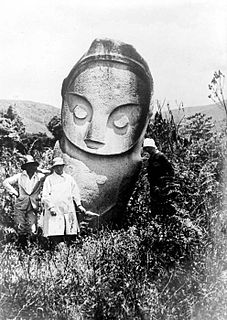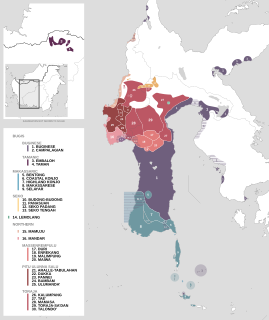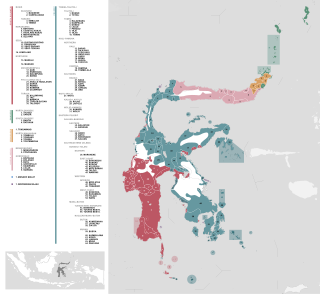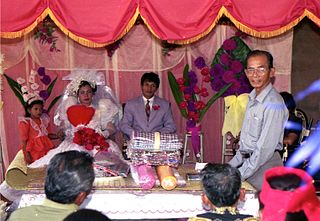Related Research Articles

Central Sulawesi is a province of Indonesia located at the centre of the island of Sulawesi. The administrative capital and largest city is located in Palu. The 2010 census recorded a population of 2,635,009 for the province, and the 2015 Census of 2,876,689, while the latest official estimate is 3,042,100. Central Sulawesi has an area of 61,841.29 km2 (23,877 sq mi), the largest area among all provinces on Sulawesi Island, and has the second-largest population on Sulawesi Island after the province of South Sulawesi. It is bordered by the provinces of Gorontalo to the north, West Sulawesi, South Sulawesi and South East Sulawesi to the south, by Maluku to the east, and by the Makassar Strait to the west. The province is inhabited by many ethnic groups, such as the Kaili, Tolitoli, etc. The official language of the province is Indonesian, which is used for official purposes and inter-ethnic communication, while there are several indigenous language spoken by the Indigenous peoples of Central Sulawesi. Islam is the dominant religion in the province, followed by Christianity which are mostly adhered by the people in the eastern part of the province.

Lore Lindu National Park is a protected area of forest on the Indonesian island of Sulawesi, in the province of Central Sulawesi. The Indonesian national park is 2,180 km² covering both lowland and montane forests. It provides habitat to numerous rare species, including 77 bird species endemic to Sulawesi. The national park is designated as part of the UNESCO World Network of Biosphere Reserves. In addition to its rich wildlife, the park also contains megaliths dating from before 1300 AD.
Moronene is an Austronesian language spoken in Bombana Regency, Southeast Sulawesi, Indonesia. It belongs to the Bungku–Tolaki branch of the Celebic subgroup.

Bada Valley or Napu Valley, located in the Lore Lindu National Park in Central Sulawesi, Indonesia, contains hundreds of megaliths going back to the 14th century that are called watu ("stone") in the local Badaic languages and arca ("statue") in Indonesian. The purpose of the megaliths and their builders are unknown.
The Kaili–Pamona languages are a branch of the Celebic subgroup in the Austronesian language family spoken in western Central Sulawesi province, Indonesia.

The South Sulawesi languages are a subgroup of the Austronesian language family. They are primarily spoken in the Indonesian provinces of South Sulawesi and West Sulawesi, with a small outlying pocket in West Kalimantan.

On the Indonesian island of Sulawesi, 114 native languages are spoken, all of which belong to the Malayo-Polynesian subgroup of the Austronesian language family. With a total number of 17,200,000 inhabitants, Sulawesi displays a high linguistic diversity when compared with the most densely populated Indonesian island Java, which hosts 4–8 languages spoken by 145,100,000 inhabitants.

Poso Regency is a regency of Central Sulawesi Province of Indonesia. The principal town lies at Poso.
Enrekang is an Austronesian language spoken on Sulawesi, Indonesia. It belongs to the Northern branch of the South Sulawesi subgroup, and is closely related to Duri and Maiwa.
The Badaic languages are a group of three closely related Austronesian languages spoken in the North Lore and South Lore districts of Central Sulawesi, Indonesia, viz. Bada (Bada’), Behoa (Besoa), and Napu. The three languages are 80–91% lexically similar and to a great degree mutually intelligible, but their speakers are culturally distinct.
Napu is an Austronesian language spoken in the North Lore district of Central Sulawesi, Indonesia. Together with Bada and Behoa, it belongs to the Badaic subgroup.
Bada is an Austronesian language spoken in the South Lore district of Central Sulawesi, Indonesia. Together with Napu and Behoa, it belongs to the Badaic subgroup.
Maiwa is an Austronesian language spoken by around 50,000 people in South Sulawesi, Indonesia. It belongs to the Northern branch of the South Sulawesi subgroup, and is closely related to Duri, Enrekang and Malimpung.
Malimpung is a language spoken by around 5,000 people in South Sulawesi, Indonesia. It belongs to the Northern branch of the South Sulawesi subgroup, and is closely related to Duri, Enrekang and Maiwa.
Sarudu is an Austronesian language of West Sulawesi, Indonesia. It is closely related to Uma.
Paku (Bakau) is an Austronesian language spoken in four villages in the East Barito Regency of Central Kalimantan province, Indonesia. It is closely related to the Malagasy language spoken on Madagascar. Most of the remaining speakers are also fluent in other languages. The use of the language is decreasing and speakers are increasingly shifting to Ma'anyan, a lingua franca of East Barito. In 2018, it was estimated there was about 50 speakers of the language in the villages of Tampa, Tarinsing, Bantei Napu, and Kalamus in the regency of East Barito.
Aralle-Tabulahan is an Austronesian language that belongs to the South Sulawesi subgroup. It is spoken in Mamasa Regency, West Sulawesi, Indonesia.
The Seko languages are a group of four closely related Austronesian languages spoken in West Sulawesi and South Sulawesi provinces, Indonesia. They make up a primary branch of the South Sulawesi subgroup. The languages of the Seko branch are: Seko Padang, Seko Tengah, Panasuan and Budong-Budong.

Pamona people inhabits almost the entire Poso Regency, parts of Tojo Una-Una Regency and parts of North Morowali Regency, Central Sulawesi; in fact there are some even in East Luwu Regency of South Sulawesi, whereas a small remainder lives in other parts of Indonesia. The ancestors of the Pamona people originally came from the land of Salu Moge because they were once from the mountains which is far from the central governance thus they were brought down by Macoa Bawalipu of Wotu, East Luwu Regency to be nearer to the central governance, which is the surrounding region of Mangkutana. But it was until a revolt by the Darul Islam (Indonesia) rebellion broke out that they spread to Central Sulawesi and to other regions. If there are Pamona people in certain regions, then it is common that a Rukun Poso is formed there, which serves as a means of a group of people from a common ethnic background to engage in various activities within the region. Almost all of the Pamona people practices Christianity. Christianity came into the region about 100 years ago and until today it is widely accepted as the religion of the people. Today, all churches of common denomination are grouped under the Central Sulawesi Christian Church headquartered in Tentena, Poso Regency, Central Sulawesi, Indonesia. A large part of the common folk uses Pamona language and Bahasa Indonesia language that is mixed with the local slang. The Pamona people are usually farmers, government officials, pastors, entrepreneurs and so on.
The Poso riots, also known as Poso communal conflict, is a name given to a series of riots that occurred in Poso, Central Sulawesi, Indonesia. This incident involved a group of Muslim and Christian in the region. The event is divided into three stages. The first Poso riot took place from December 25 to 29, 1998, and the second one was from April 17 to 21, 2000, and the final one was from May 16 to June 15, 2000.
References
- ↑ Behoa at Ethnologue (18th ed., 2015)
- 1 2 Martens, Michael P. (1989). "The Badaic languages of Central Sulawesi" (PDF). In Sneddon, James N. (ed.). Studies in Sulawesi Languages, Part 1. Jakarta: Universitas Katolik Indonesia Atma Jaya. pp. 19–53.